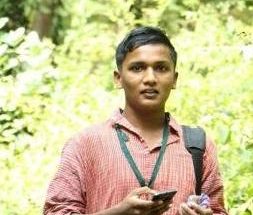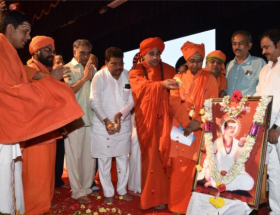Gurinder Azad
If anyone has left a rich legacy of aggressively challenging Brahmanism, it is our own Periyar. His full name was Erode Venkatappa Ramasamy Nayakar. Periyar means ‘great man’. Bahujan youth today express their aggression and restlessness against the Brahmanical system by sharing quotes of Periyar on social media, and strive to advance the movement. Periyar, who invoked such enthusiasm in the Bahujans and who is known as the ‘Father of the Dravidian Movement’, was born on 17 September 1879 in Erode (now a district) of Tamil Nadu.
Let us know about Periyar through some significant incidents.
Periyar thought the Congress was doing a good job, so he joined the Congress in 1919 to work for his society in a political capacity. But, after a year, the hope was shattered as he realised it was an illusion. In a Congress programme, he discovered that there were only upper caste individuals present. More than 98% of those on stage discussing India’s future belonged to the upper castes. Periyar was enraged. He formed his own Bahujan delegation and held his own parallel session. He was persuaded by the Congress to stay. He probably decided to give it another chance when he remained in it for a little longer .
He was appointed president of the Madras Presidency Congress Committee in 1922. He sought reservations for the marginalized castes in jobs and education, but was unsuccessful for ‘obvious reasons’. He summarized the Congress: this is a highly arrogant group.
In 1925, he left the Congress and launched his own programme, the ‘Self-Respect Movement’. There was a specific reason for this. Those days, Gandhi was well-liked within the Congress. He was attempting to woo those Dalits, whom he referred to as Harijans, using the formula of favour. Innocent Bahujans were also taken in by his ruse. Periyar understood the origins of discrimination. Gandhi’s tactics did not sit well with him. An incident occurred, which is as follows: in 1923, at a Congress meeting in Kakinada (in the present East Godavari district in Andhra Pradesh), a report citing discrimination against the Depressed Classes in Kerala was presented. As a result, a committee was formed in Kerala. It was decided to launch a movement to gain temple entry for the Depressed Classes and also the right to use public roads.
The movement got underway. The Akalis (Akali Dal) of Punjab extended their solidarity to the agitators by setting up ‘langar’ (free public kitchen). This demonstrates how widely this movement had gained prominence. Periyar actively participated in this movement. But Gandhi came and shunned the movement. He believed that it was an internal matter of Hindus. The agitators did not accept this. The movement went on and arrests were made. Periyar was also arrested. From the start of the movement to the arrests, the following year (1924) was almost halfway through. This effectively ended any further dialogue with Gandhi for Periyar. So, the Self-Respect Movement was not only a concrete practical answer to this, but it also had its own position from the Bahujan point of view.
Just as Kanshi Ram ji, who was born 55 years after the birth of Periyar, felt a strong need to form a political party by organising the Bahujan Samaj. Periyar who was witness to Congress leaders’ refusal to accept the demands of Bahujan, quit the Congress in 1925 to launch the “Self-respect Movement.” Periyar was to subsequently lead the Justice party in 1938 following the tremendous growth of the Self-respect Movement. Justice party was started in 1916 as a political party by a group of rich and educated Bahujan to oppose Brahmin hegemony in jobs, education and in social order. It was Justice Party that brought in the first reservation in the region in 1920 when Periyar was still with the Congress. Periyar supported the Justice Party. The first bill of reservation provided for reservations for lower castes at all levels.
The Brahmin intelligentsia in the Congress were enraged. They contended that the bill would destroy the roots of India’s integrity, that it was drafted at the request of the British rulers, and that the Justice Party was an agent of the Whites… This is how Brahmins of the Congress created a narrative to accuse Periyar of being a tool of the British government.
It was too much for Periyar. He was skilled at responding. You know what he said to the caste that considers itself superior-If you see a Brahmin and a snake at the same time…. anyways!
Periyar travelled to the Soviet Union in 1932. He was influenced by that government’s work and became a socialist. He returned to India and joined the left forces. The elections in 1934 shattered his illusion that the Indian Left was truly socialist. The Congress was already opposed to Periyar, and the Left parties also opposed him, claiming that the Justice Party was not nationalist and that it incited people to fight each other, and that they (the Left) would support the Congress. Periyar immediately removed himself from any circle of friendship. He exclaimed, “These are Brahmin-comrades!!”
As many of you probably know, when Nehru’s government was formed in 1950, the first thing he did was to try to torpedo reservation. The Nehru government said that because there was no provision in the constitution for the implementation of reservation policy, it was anti-constitutional and should be abolished with immediate effect.
This is called a gambit. They avoided liability by pitting Periyar’s reservation policy against Dr. Ambedkar’s constitution. Periyar responded angrily saying, “Four out of five members of the Constitution Committee were Brahmins. What could Dr. Ambedkar have done in that situation?” Periyar became enraged. Tamil Nadu saw this outpouring of rage. In Tamil Nadu’s streets and alleys, there was a flood of people protesting the Nehru government. Periyar foresaw India becoming the arena for a Brahmanical system. He advocated for independence from India. “We don’t want to stay in India!” Congress was jolted. The Congress amended the constitution, and the bill opposing the reservation was withdrawn. Despite this, Periyar refused to be a part of India until 1952.
Periyar was a firm believer in action plans. Action plans are not created by chance. Decisions must be made. His decisions were correct. This would not have been possible without the clarity that comes from working with the society and seeing and examining historical and personal experiences. Periyar went through these exercises and thus he became the torchbearer of ‘Bahujan Autonomy’. The second noteworthy aspect of him is that he recognized the importance of regional languages, as well as the culture and civilization that flourished in the lap of regional languages. That is why, when he rejected the Indian Union, claiming it was a Brahmin empire, he declared, “Dravidian language, Dravidian people, Dravidian culture, and Dravidian region… this is my country.”
In independent India, the Congress was not only responsible suppressing the movement raised by Periyar, but it also used this ‘worth’ to put an end to the movements in other states. Before his death in 1973, the Dravida Party split into several branches..
Tamil Nadu had remained in the shadow of the extreme domination of Brahmins, where conservatism thrived, for a long period. Periyar brought a ray of sunshine to the land of Tamil Nadu. However, such Brahmin supremacy did not exist in other places. I am very familiar with (undivided) Punjab. Every state has its own story to tell. It is important to understand this story. It is necessary to look back in history and understand where we were when the caravan began and what the current conditions tell us. By addressing this question, many unnecessary and cumbersome issues will be resolved. And clarity would be an added bonus!
How the Akali Dal, which was formed in 1920 and was setting up langar in the Dalit movement in 1923 (in Kerala), came to form an alliance with the BJP in independent India is a different chapter in history. As previously stated, the Brahmin-Congress came to power after the British left and was in a position to carry out many of its agendas with the help of factions such as the Akali Dal. Knowing Periyar, this type of questions occurs to me, but Periyar has also provided a solution. Many Bahujans do not understand the narratives on which India stands today, while Periyar has already spoken unequivocally on the subject. We must take his name with a lot of responsibility on his birth or death anniversary. We must remember Periyar by taking a hard look in the mirror.
~~~
Gurinder Azad is a poet, writer, documentary filmmaker. He is also the Editor of Round Table India (Hindi).










